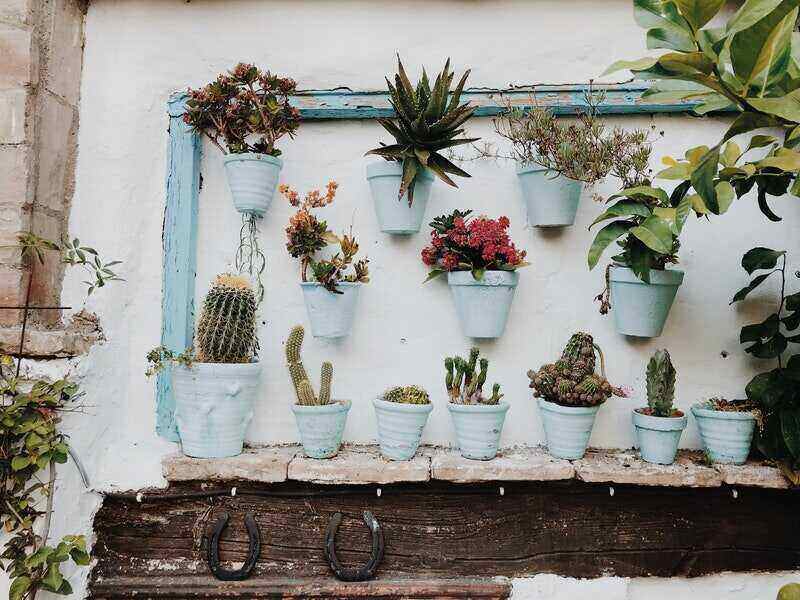
With a kitchen just big enough for one small countertop and a bathroom just big enough for the mega toilet paper roll, how can your New York apartment be big enough to grow a plant, let alone a garden landscape? Thanks to these 20 vertical gardening ideas for NYC homes –– it just might be.
Whether you’re a New York City homeowner with a small yard or an apartment dweller with tight walls, a vertical garden can help you exercise your green thumbs without losing valuable space. Vertical gardening offers a higher sense of well-being, keeps out the weeds, adds charming home decor, and saves space.
We’ll let you in on 20 vertical gardening ideas and the advantages, best plants to grow, maintenance tips, and expected costs of each one. So grab your drill, slip on the goggles, and let’s get started.
1. Look to the ceiling
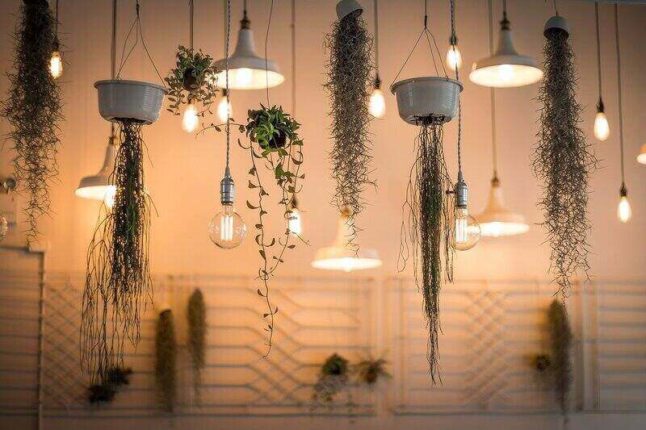
If your NYC apartment or home lacks floor space, wall space, or furniture surface area for a houseplant, keep your chin up because that’s where you’ll find your answer –– the ceiling. Hang your favorite plants from the ceiling for added texture and decoration.
Keep in mind that adding hooks to your ceiling is a permanent fixture that won’t be coming out of the ceiling anytime soon. You may need to ask your landlord if it’s OK to install a hook.
Advantages:
- Avoids creating plant clutter in your limited spaces, like tables and shelves
- Hanging your plants keeps them away from pets and small children.
- You can hang your decorative plants at eye level.
- Easy to manipulate different heights for added style and appeal
- Allows you to grow long, leafy plants you couldn’t have otherwise grown
Best plants:
- String of pearls
- Boston fern
- English ivy
- Ripple peperomia
- Spider plant
- Burro’s tail
- Golden pothos
Maintenance tips:
- Plants can get pretty heavy, especially after you add potting soil and water. Purchase a durable hook and hanging basket that can withstand heavier weights.
- Don’t install your hanging pot too close to the wall; otherwise, the pot may continue to hit the wall, or the plant may not have enough room to grow.
- Drainage is essential (the last thing you want is water getting all over your white rug or furniture). Ensure the plant is either in two pots — the one with drainage holes is inside another pot without drainage holes — or that the plant’s pot has an attached saucer to catch the draining water.
Cost: Ceiling hooks typically cost between $2 and $15, depending on durability and style. A hanging planter costs around $15.
2. Decorate a tiered wooden ladder
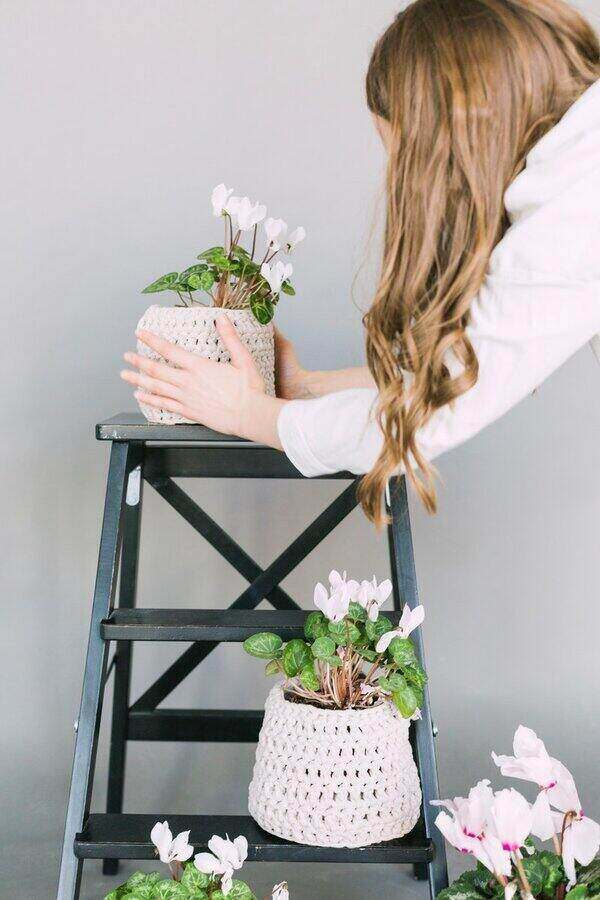
Before you buy a ladder to hang your ceiling plants, think about how that ladder can act as an ornate piece in the apartment. You probably won’t have enough storage space for it, so buy a ladder you’ll love to show off in the corner of the room.
And make sure your green friends love it too. A tiered ladder makes an excellent surface for growing a vertical garden. Just stack your potted plants on each level, and you’ll love the beautiful, upward display it creates.
Advantages:
- Arranging the plants is easy (and so is changing the arrangement).
- A ladder can act as a trellis and grow climbing plants.
- A wooden tiered ladder makes an attractive focal point and can fit into almost any home decor style.
- You can later use the ladder when you water any ceiling plants.
Best Plants:
Grow any plants that thrive in pots. We recommend decorative flowers that will turn your ladder’s vertical garden into an art piece, but herbs work just as well.
- Geranium
- Orchid
- Peace lily
- Succulents
- African violets
Maintenance tip: Sometimes, small fungus gnats can plague your houseplants. To avoid these unwanted visitors, don’t overwater your plants. If these pests are already running amok, there are plenty of natural remedies. Let the soil completely dry out before the next watering, or apply neem oil to keep these pests under control.
Cost: A wooden tiered ladder may cost you between $50 and $150.
3. Adorn your bookshelves
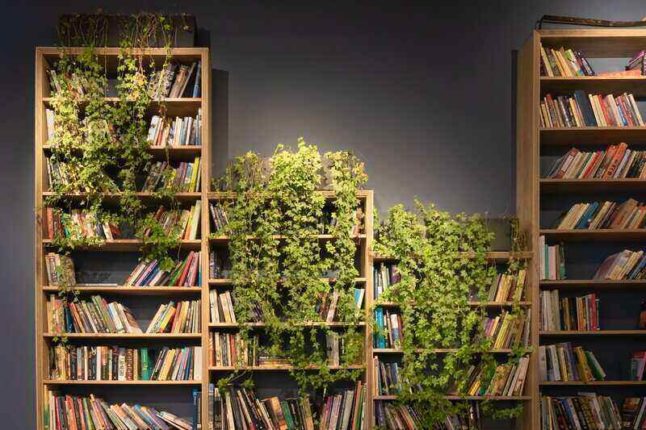
Grow your prized vertical garden on your bookshelf. Grow small succulent plants to act as bookends or drape the top shelves with trailing plants.
Advantages:
- Allows you to grow draping plants if hanging them is not an option
- If your shelves show off decorative decor rather than books, a plant can highlight your favorite trinkets.
- Ever-changing arrangements
- Easy access when watering
Best plants:
For bookshelves, we recommend trailing plants or textured plants that will attract the eye.
- Succulents
- Devil’s ivy
- Chain of hearts
- Lipstick plant
- Spider plant
- Inch plant
Maintenance tip: Sometimes trailing or climbing plants can get out of control if not properly cared for. Remember to trim or prune these plants to ensure healthy and controlled growth.
Cost: Trailing plants usually cost between $10 and $20 each, though this can vary depending on the plant type.
4. Install floating wall shelves
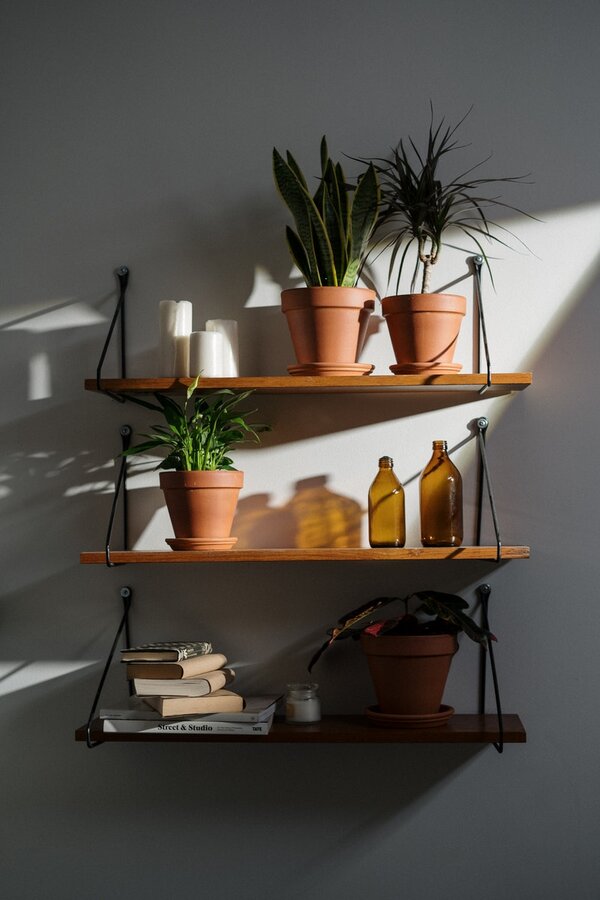
Install a few matching shelves into the wall for added home decor and a place to grow your vertical garden. If you’re renting, make sure you have your landlord’s permission before drilling holes into the wall.
Advantages:
- You get to choose where on the wall you grow this vertical garden. Remember to pick a spot that receives plenty of sunlight.
- You get to set the appropriate level –– no bending over or ladders needed when watering or maintaining this vertical garden.
Best plants:
Since you get to choose where to hang your shelves, how about growing a potted herb garden in the kitchen? These are among the best herbs for container gardening:
- Mint
- Basil
- Rosemary
- Sage
- Thyme
- Lemon balm
- Parsley
- Oregano
Maintenance tip: To encourage new growth, pick from your herbs often, starting from the outermost leaves.
Herbs like basil and mint begin to lose their flavor once the flowers start to form. Pinch off the flower buds to ensure the herbs retain their delicious taste.
Cost: A packet of herbs usually will run you between $1 and $2. Shelf sets range between $20 and $30 depending on the set’s size and design.
5. Mount your plants to a wall
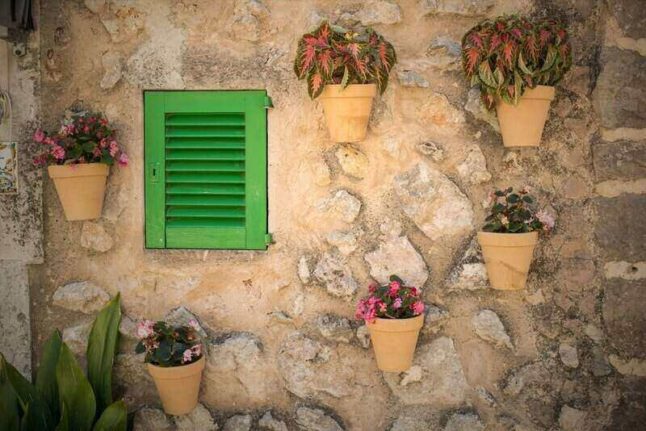
Showcase your terracotta plants and display them on the wall. If your apartment is overflowing with plant stands or the cramped front yard has no space for a garden, turning to the walls for support is one of the best vertical gardening ideas. Install the right pot clip hanger, and your terracotta pot’s rim can fit snuggly right into the clip.
Advantages:
- This vertical garden idea doesn’t require furniture or decor to install. One clip hanger is all you need.
- You can ensure your plant gets the needed sunlight.
- You can show off your plants without overcrowding the bookshelf or front lawn.
- Hanging your plant on the wall turns it into an art piece.
Best plants:
The best pots to hang are terracotta pots because of their rim. Because terracotta pots don’t retain moisture, you’ll want to pick plants that don’t mind the dryness, such as succulents and cacti.
Maintenance tip: If hanging your terracotta plant indoors, make sure your pot has a saucer attached. Otherwise, your pots will drain all over your nice rug after watering them.
Cost: Clips usually cost about $1 each and are often sold in sets. Terracotta pots may range between $1 and $10 or more, depending on the size.
6. Show off a window box
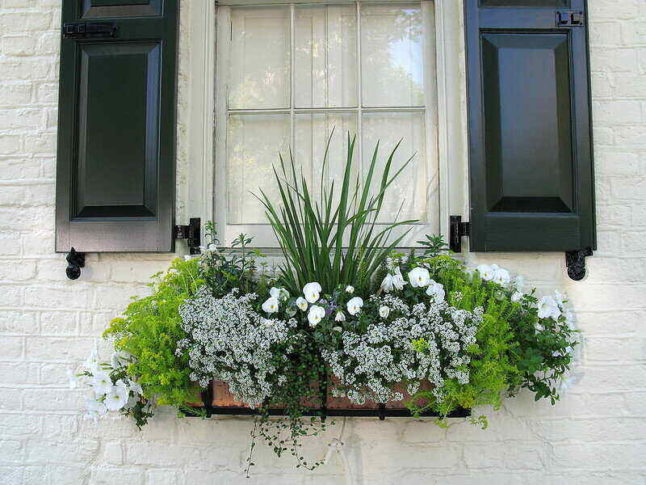
Window boxes are among the best assets for your kitchen and also one of the best vertical gardening ideas. Your herbs will get all the sunshine they need to give you that delicious flavor, and you don’t have to travel to the garden to pick them.
If your window has an adjustable screen or no screen at all, that’s even better. Just open the window and pick your herbs while standing right in the kitchen.
Window boxes are also an excellent container for growing flowers. Make your house stand out from the rest with beautiful floral arrangements around your windows.
Advantages:
- Offers better weed control than growing your herbs in a garden
- A decorative window box offers a beautiful view from your favorite window.
- A window box can help cover up scratches on your window frame.
- It adds an extra splash of color and texture to your home’s exterior.
- Growing your plants in a window box puts them at eye level.
Best plants:
Decorate your window box with a variety of colors, textures, and growth patterns. Before picking your favorite plants to show off, make sure you know how much shade or sun your window box will receive.
Window box plants that prefer shade:
- Parsley
- English daisy
- Johnny jump ups
- Snapdragon
- Pansies
Window box plants that prefer sun:
- Lavender
- Marigold
- Rosemary
- Dusty miller
- Periwinkle
Climbing window box plants:
- Carolina jessamine
- Honeysuckle
- Moon vine
Trailing window box plants:
- Strawberries
- English ivy
- Alyssum
Maintenance tip: For easy maintenance, grow plants that get along. They’re all going to be sharing the same home, so don’t grow one plant that needs plenty of water and another that prefers dry soil. Stick with flowers that harmonize, and your maintenance routine will be straightforward.
Cost: Window box prices will vary between $5 and $400 depending on its design and material.
7. Grow a pallet garden
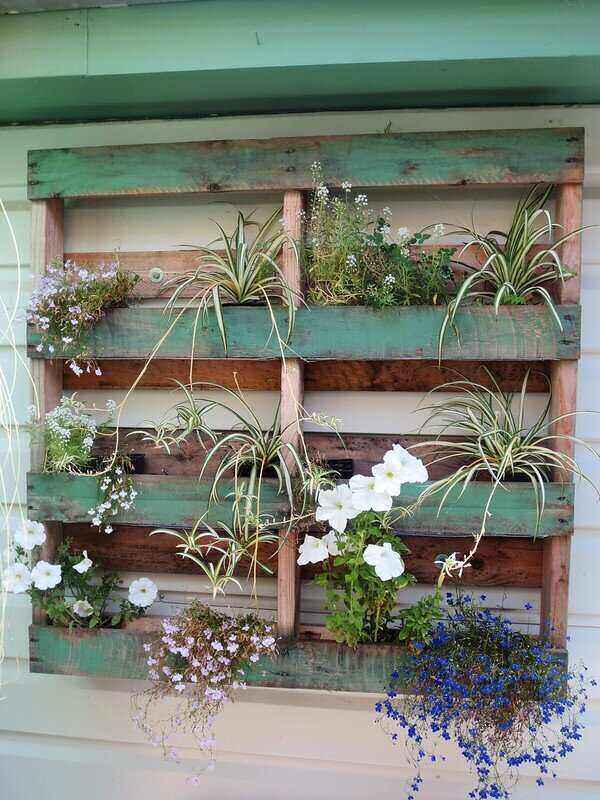
A pallet is a flat platform that enables easy handling, shipping, and lifting of commercial goods or containers. Its structure makes it easy to grow small flower and vegetable gardens –– one of the best vertical gardening ideas for homeowners who don’t have the yard space to grow a vegetable garden. Hang the pallet on the wall, or set it out on the balcony for added appeal and extra gardening space.
Advantages:
- Allows you to create an organized vegetable garden with tall plants on top and trailing plants on the bottom
- Reduces weeds
- Holds the soil in place
- Vegetables thrive in pallets
- Can make a great alternative to traditional gardens
Best plants:
Veggies to grow on top:
- Tomato varieties like Tiny Tim, Small Fry, and Toy Boy
- Eggplant
- Cabbage
- Peppers
- Bush beans
Middle:
- Lettuce
- Spinach
- Basil
- Rosemary
- Thyme
- Oregano
- Mint
- Sage
Bottom:
- Small melons
- Summer squash
- Cucumbers
Maintenance tip: If making your pallet, only use pallets labeled HT. Pallets labeled with HT means they were heat treated rather than chemically treated. Chemically treated wood panels may not be healthy for your plants.
Because space between plants is limited in a pallet garden, diseases and pests can quickly spread. Either grow plant varieties with high disease and pest resistance or keep a watchful eye on your plants’ health to make sure diseases don’t take over.
Cost: Pallet costs range from $5 to $200 depending on size, quality, and material.
8. Revamp your shoe organizer
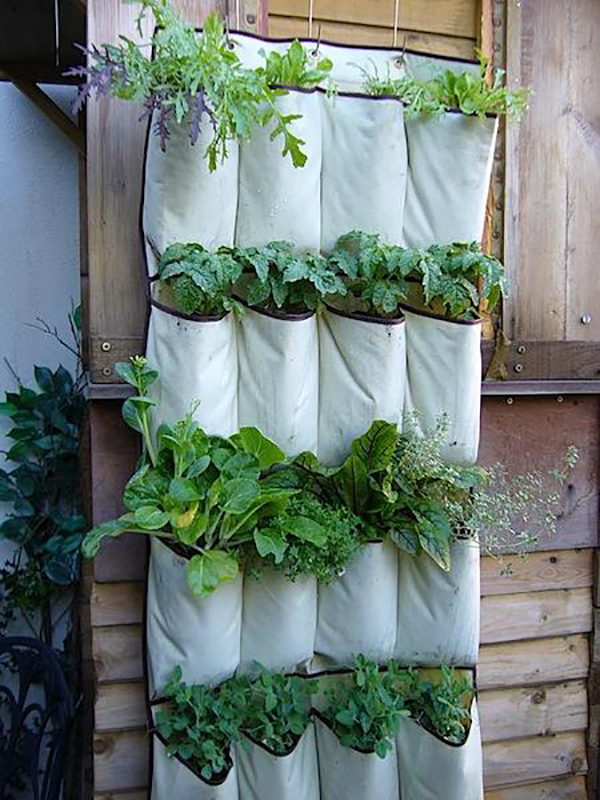
This is one of the best low-cost vertical gardening ideas and is perfect for the DIY enthusiast. Before you throw away your old shoe organizer, consider if you can use it for your new vertical garden. Buy a few hooks, fill the pockets with compost or soil, sow your seeds, and you’re ready to go! Hang the shoe organizer on a wall or outside on the porch railing.
Advantages:
- Hanging the garden off the ground helps ensure slugs and snails won’t make their way to your plants.
- This vertical garden idea is easy to move around whenever you need to change its location.
- Weeds hardly become an issue.
- Organizing your herbs is simple.
Best plants:
Spruce up your shoe organizer with your favorite small flowers or tasty herbs.
- Lemon balm
- Parsley
- Sage
- Thyme
- Oregano
- Mint
- Basil
- Rosemary
Maintenance tip: If your shoe organizer’s pockets don’t drain, poke a few small holes at the bottom of each. Catch any dripping water with a small box at the bottom of your vertical garden.
Water the pockets whenever the soil is dry. You may need to water your vertical garden every day if the soil dries out fast.
Cost: If you don’t have a shoe organizer, you can buy a cheap one for under $10.
9. Make a succulent wreath
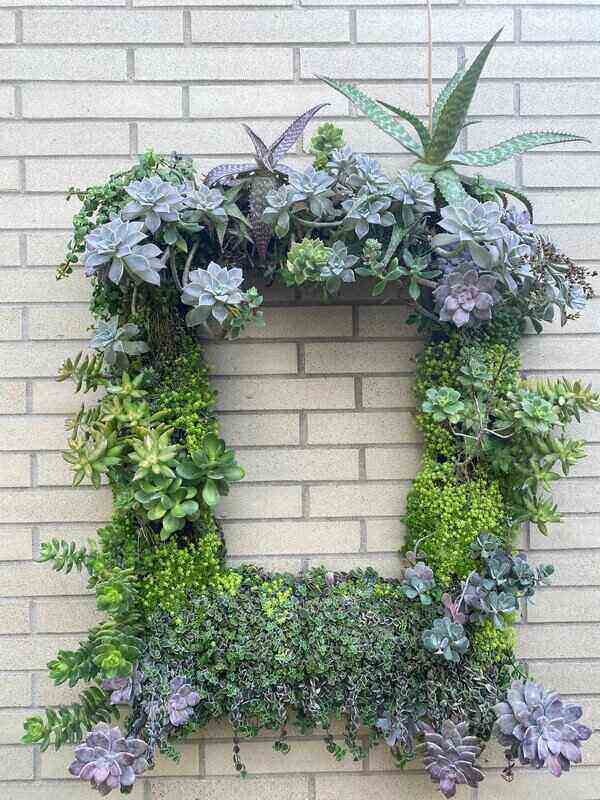
A treat for the eye, succulents come in remarkable shapes, sizes, colors, and textures. Decorate your walls or front door with succulent wreaths — one of the best vertical gardening ideas that makes a stunning first impression.
Check out how Garden Answer builds an eye-catching succulent wreath with a moss wreath form, succulent cuttings, scissors, and greening pins.
Advantages:
- No messy soil, garden pots, or an outdoor succulent garden to tend to –– just decorate your moss wreath and hang.
- No more shelves or tables cluttered with succulents
- Creates both an art piece and a vertical garden
Best plants:
When shopping for succulents, make sure to buy succulent cuttings rather than a succulent in a small pot.
Maintenance tip:
- Allow the wreath to lay flat for four to six weeks so the succulent cuttings cab develop roots.
- Introduce the wreath to sunlight over one week.
- Water every three to 10 weeks, depending on the time of year. Lay the back of the moss form in a tub of water for one hour. Avoid getting the succulents in the water.
Cost: A moss wreath form costs between $10 and $50, depending on the shape and quality. Succulent cuttings typically cost less than $1 each and are sold in bulk. Greening pins cost roughly $6 a pack.
10. Invest in a smart garden
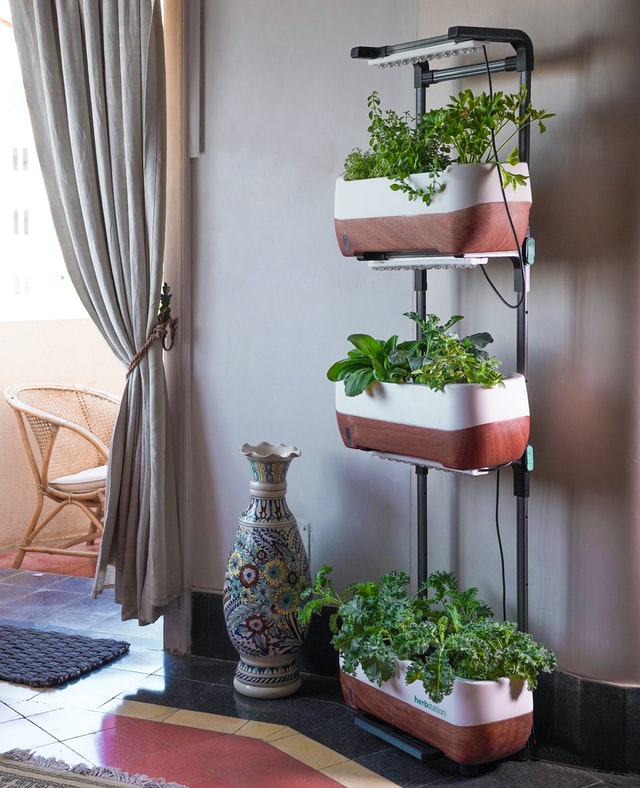
Smart gardens are some of the best vertical gardening ideas for gardeners whose apartment or home gets little sunlight or has small space. Though on the pricier end, these self-sustaining gardens often come with their own grow light and have a self-watering planter. So if you’re always on the go in the concrete jungle, a smart herb garden will ensure your leafy friends never miss a watering.
Some smart garden products even come with their own vertical stand to help you save space in the kitchen and grow as many herbs as you please without losing counter space.
Advantages:
- Many smart gardens are self-sustaining and require little effort from you.
- Perfect for apartments and homes with little sunlight and less space.
- Can offer a fun and positive gardening experience for beginner green thumbs.
- Instructions are often simple and easy to follow.
Best plants:
Most smart gardens come with a pack of herbs that grow best with the product.
Maintenance tip: A self-sustaining garden typically saves you from backache. Most smart gardens will require routine cleaning whenever you change out the plants. Some are even machine washable.
Cost: Smart gardens generally cost between $100 and $200 or more depending on the company you buy from and the garden’s size.
11. Build or buy a hydroponics system
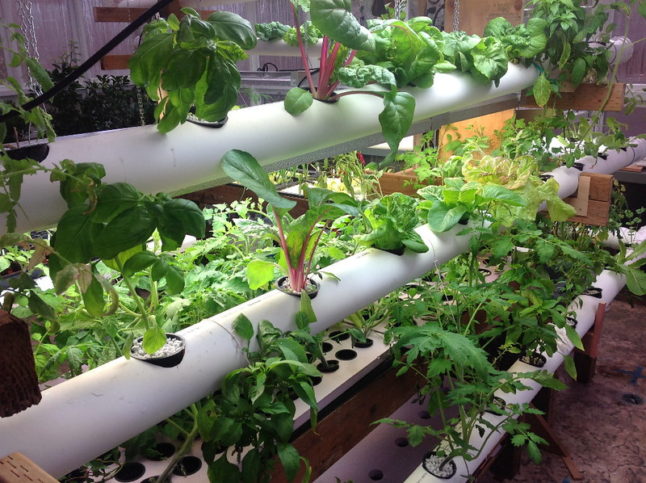
Hydroponics is a gardening method that grows plants without soil. Instead of soil providing your plants with nutrients, the water is doing all the work. In a hydroponic garden, the nutrients are dissolved in the water, and the roots can access the nutrients with ease.
There are many different hydroponic systems. In some hydroponic gardens, the plant’s roots are sitting right in the water. Other hydroponic systems have the plants growing in a soil substitute, like sand, gravel, or aged bark.
As one of the best vertical gardening ideas, you can build or buy your own hydroponic system. Many hydroponic systems in stores have a sleek design and are useful for saving space. When making your hydroponic system at home, saving space will often add to the challenge.
Advantages:
- Gardening without soil helps to prevent soil-borne disease.
- With limited pests and diseases, you’ll likely use fewer pesticides and chemicals.
- Growing your plants in nutrient-rich water can allow your plants to absorb nutrients faster than when grown in soil. This advantage can lead to faster plant growth.
- Hydroponics uses less water than a traditional garden.
- No soil erosion
Best plants:
Your hydroponics system can feature various herbs, vegetables, fruits, and houseplants.
- Oregano
- Chives
- Basil
- Sage
- Mint
- Strawberries
- Tomatoes
- Lettuce
- Spinach
- Cucumber
- Peace lily
- Devil’s ivy
- Spider plant
Maintenance tip: Keep your hydroponic garden’s water reservoir clean and sterile. Otherwise, you risk exposing your plants to bacteria. One of the best ways to keep the reservoir clean is to change the water every few weeks. How often you need to change the water will vary depending on the system.
Cost: There are several hydroponic choices available for under $100. Larger systems can cost up to $800 or more.
12. Reuse old water bottles
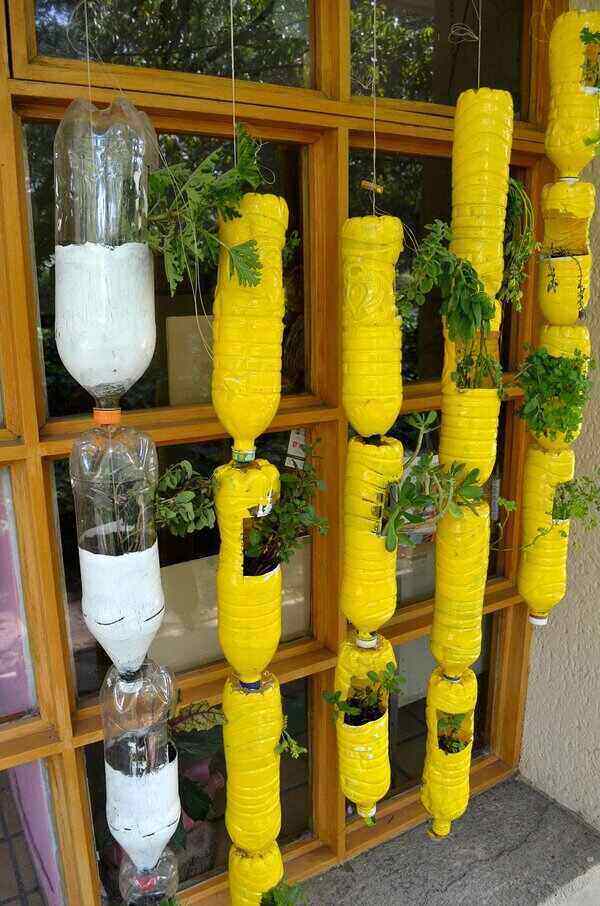
If your recycling bin is overflowing with crinkly plastic bottles, let’s turn them into a savvy vertical garden for your balcony, window, or porch.
Hang the bottles upside down or on their sides. Cut a space for the plant to grow, poke a few drainage holes, add soil, and you’re ready to go!
Checkout how 5T1 Balcony offers one of the best vertical gardening ideas with old plastic bottles.
Advantages:
- Keeps a few plastic bottles from ending up in the landfill
- Easy and simple to make
- Easy to decorate and personalize
- No weeding
- Plastic pots are great for moisture-loving plants.
Best plants:
- Basil
- Parsley
- Oregano
- Thyme
- Sage
- Rosemary
- Spinach
- Green onions
- Strawberries
Maintenance tip: If you’re growing your vertical bottle garden inside, you’ll need to find a way to collect the drainage. One way is to hang the bottle upside down so that the bottle’s cap is facing down. Poke a hole in the bottle cap so the water can drain out.
Cut a second bottle in half, and slide the second bottle’s bottom half over the upside-down bottle’s cap. The second bottle will now act as a basin for the drainage.
Cost: This is one of the best vertical gardening ideas and it should cost you very little. All you need to purchase is the soil and plants. For the most eco-friendly and cheapest option, use old water bottles you planned to toss rather than buy new, empty bottles.
13. Grow an aeroponics garden
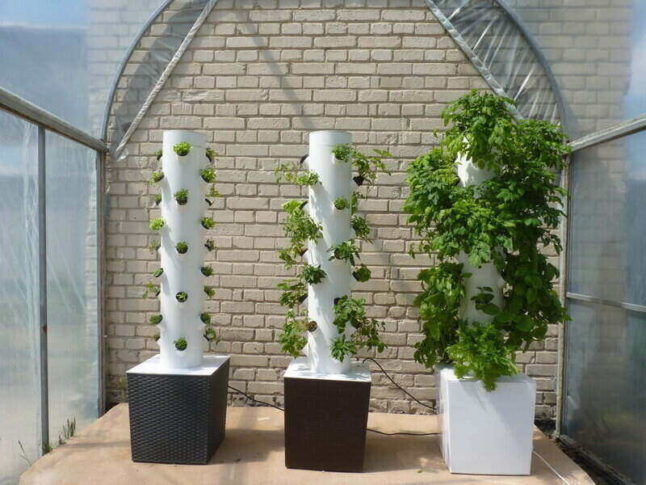
Hydroponic and aeroponic gardening systems are famous for producing delicious harvests without using soil. The two approaches are similar, but there is a difference.
Hydroponics is the gardening method of growing plants without soil. Instead, it’s a nutrient-rich water solution that does most of the work. The plants’ roots are typically submerged in this enriched water, though sometimes they are grown in another soil substitute, like sand or soil. There are many different types of hydroponic systems, and aeroponics happens to be one of them.
Aeroponics also grows its plants with a nutrient-rich water solution. But instead of the plant’s roots sitting directly in the water like in other hydroponic systems, the roots are exposed in an aeroponics garden and sprayed with the solution.
Advantages:
- Sustainable gardening system for green thumbs with little to no gardening space.
- The soil-free system helps to prevent soil-borne disease.
- Fewer pesticides and chemicals are needed to control pests and disease.
- No soil erosion
- Requires less water than a traditional garden
- Roots have better access to oxygen.
- Roots have a better chance of not becoming water-logged.
- Nutrients can be applied with precision.
- Easy access to roots
- Reduced fertilizer use
- Some designs come with an LED light, making growing indoors less of a challenge.
Best plants:
- Lettuce
- Kale
- Herbs
- Tomatoes
- Peppers
- Snap peas
- Cucumbers
- Small flowers
Maintenance tip: When growing your plants, grow the same sized plants next to each other. Otherwise, a tall plant may block a small one from the LED light.
Cost: Some aeroponic gardening systems are available for around $100, but more advanced systems can cost up to $1,000 or more.
14. Watch climbers grow up a trellis
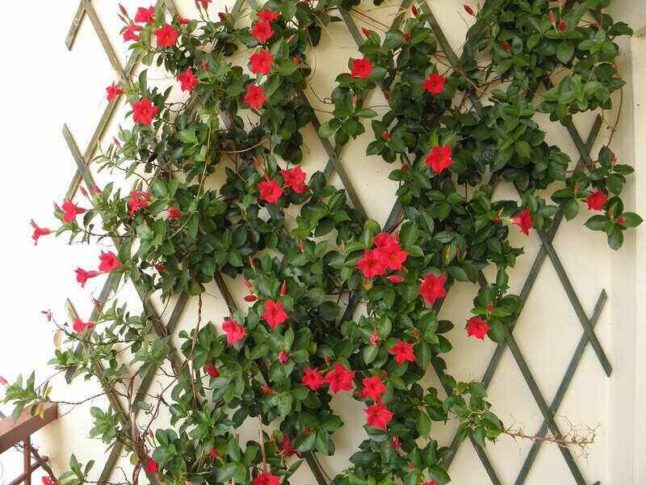
A trellis is a structure with an open framework that allows various types of plants to grow upward. If you have a small garden or yard, there are plenty of trellis ideas and designs to take advantage of, including wall trellises, freestanding trellises, and planter box trellises.
Instead of growing rose or hydrangea bushes that take up space in the small yard, consider growing climbing varieties that will still give you a beautiful yard while conserving space.
Trellises come in many shapes or sizes and can be indoors or outdoors. They are also suitable for many garden types, including flower beds, container gardens, and vegetable gardens.
Advantages:
- Helps keep vegetables off the ground and away from soil-borne diseases
- Increases airflow and allows damp leaves to dry off
- Makes harvesting vegetables an easier task
- Exposes more leaves to sunlight
- A large trellis with climbing vines can help absorb sound and create privacy.
- A well-designed trellis can make an attractive centerpiece or wall art.
Best plants:
Your trellis can feature several vegetables, fruits, and vining flowers, including:
- Tomatoes
- Beans
- Peas
- Squash
- Melons
- Clematis
- Climbing rose
- Climbing hydrangea
- Wisteria
- Morning glory
Maintenance tip: Some climbing vines can get out of control fast. Remember to prune your flowering vines to ensure controlled growth coupled with abundant blooms.
Cost: Prices will vary depending on the trellis’ size. Some trellises cost as low as $10 while others may cost $150 or more.
15. Upcycle your gutters
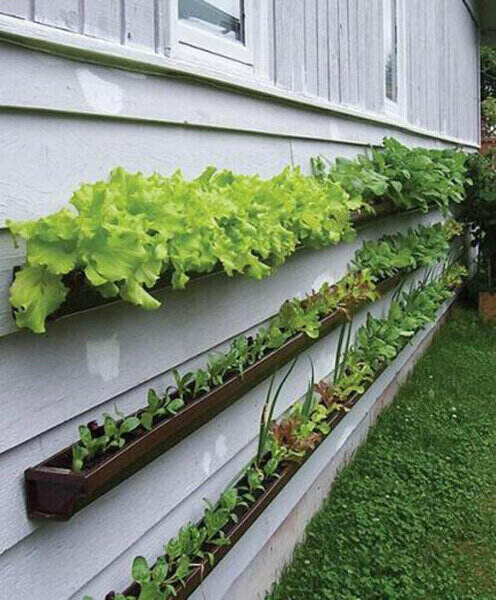
Install old gutters along your home’s exterior, around your yard’s fence, or even inside your apartment. The idea of gutters indoors may sound strange, but the right gutter garden design could work like a charm in your busy kitchen, green home office, or zen bathroom.
Advantages:
- Gutters are one of the best vertical gardening ideas because they are kept high off the ground and away from pests.
- Growing flowers in gutters can add beautiful textures and design to a bare vertical space.
- Hanging a large number of garden gutters can create a useful privacy screen.
- Is a useful way to upcycle old rain gutters
Best plants:
For this vertical garden idea, stick to plants with shallow roots.
- Strawberries
- Lettuce
- Radishes
- Spinach
- Herbs
- Succulents
- Petunias
- Geraniums
- Marigolds
Maintenance tip: Before installing your gutter planters, drill a couple of drainage holes at one end of each gutter. When you install the gutters, make sure the end without drainage holes is slightly higher than the end with drainage holes. Installing your gutters in a straight horizontal line could prevent the water from draining.
To collect the drainage, align the gutters so that the drainage falls into the gutter below. Or use a cup to gather the drainage when watering.
Ensure your gutter material is safe for your plants. Some plastics, like PVC, are toxic to plants and can leach into the soil.
Cost: This vertical garden idea will vary in price depending on the gutter’s material, length, and the number of gutters you need. For the cheapest solution, use your home’s old rain gutters.
16. Stack the garden beds
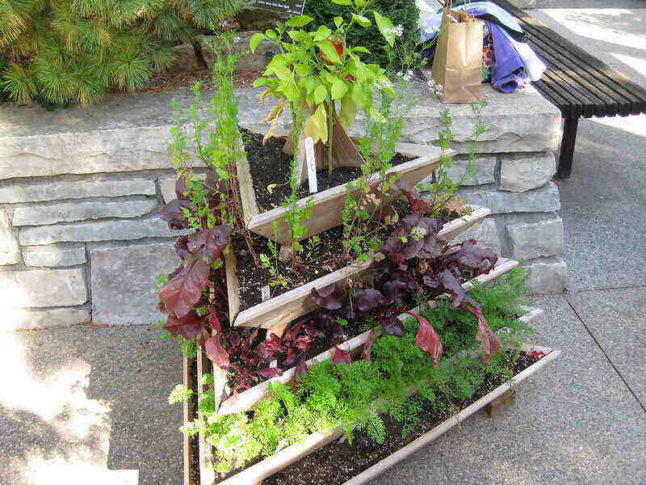
Your vegetable garden may have room for one bed, but does it have enough garden space for a few more? If you’re squeezing in all the vegetables you can, this is one of the best vertical gardening ideas that won’t make your vegetables compete: Tiered or pyramid garden beds.
Stacking your garden beds allows you to take advantage of more growing space and healthier plants. The higher your garden beds are off the ground, the harder it is for pests to invade.
Advantages:
- Fewer pests and insects
- Appealing to the eye
- Less bending over to maintain the garden
- Conserves garden space
- Enables you to control your gardening soil
- Helps prevent erosion
Best plants:
Various vegetables, flowers, herbs, and fruits grow well in raised beds. Before growing any plant, make sure the raised garden bed’s depth is suitable for your plant’s roots.
Maintenance tip: Make sure your beds are level when stacking. A level garden bed ensures good drainage.
When designing your beds, avoid making them too wide. Otherwise, you’ll have difficulty maintaining the plants growing in the middle or across the bed.
Cost: A DIY raised garden bed can cost about $30 to make. This price will rise depending on how many tiers you add to your stacked pyramid garden.
17. Dress up your drawers
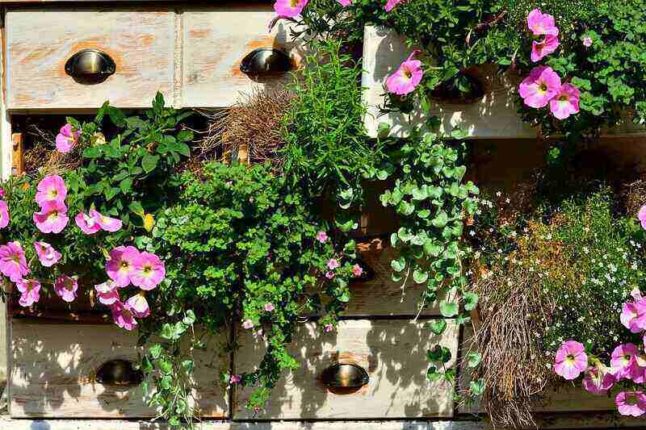
Going for the shabby chic vibe or don’t know what to do with an old dresser? Move that piece of furniture to the porch, and let’s fill it with some soil and flowers. You’ll have the coziest cottage on the block, and you’ll love caring for the beautiful flowers you finally have room to grow.
Advantages:
- Can include storage space for your gardening tools
- Repurposes an old piece of furniture
- No weeding
- Adds a one-of-a-kind showpiece to your landscape
- Lets you show off your favorite containers on top of the dresser
Best plants:
When growing plants in shallow containers (or in this case, drawers), it’s best to opt for plants with small root systems, such as:
- Petunias
- Geraniums
- Marigolds
- Lettuce
- Herbs
- Cucumbers
- Carrots
- Radishes
- Strawberries
Maintenance tip: You need to take care of a few things before growing your plants in the dresser.
- Make sure the drawers are sturdy. You can reinforce them with a drill and screws.
- Treated wood can leach chemicals into the soil. If your dresser is treated or you’re unsure if it is, cover the drawers’ bottoms and sides with an appropriate liner to separate the soil from the drawers.
- Drill holes at the bottom of each drawer for proper drainage.
Cost: A new dresser can cost around $100, but for this shabby chic look, we recommend a used dresser. Head to the flea market or thrift store for an affordable dresser or use the old dresser from your bedroom.
18. Use an A-frame
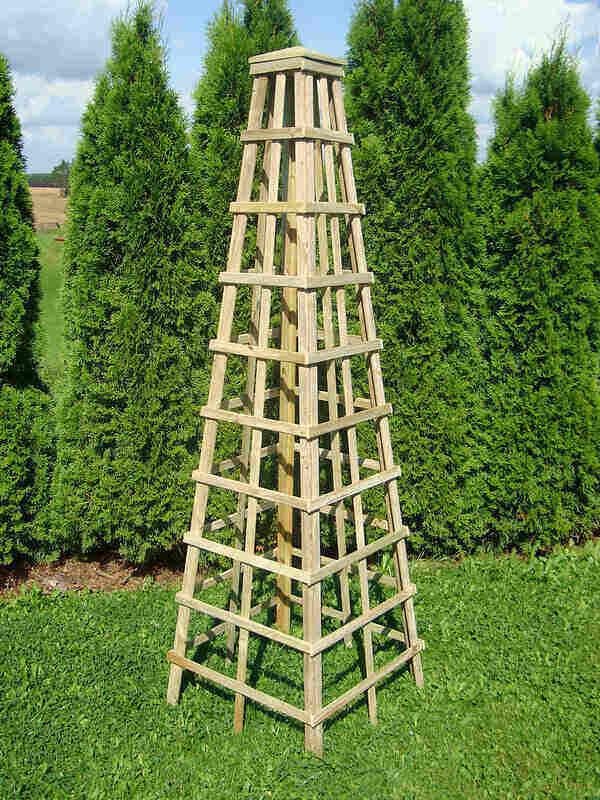
An A-frame garden trellis is one of the best vertical gardening ideas for your pole beans. The frame’s tall height and lean structure can make it an appealing focal point in your small vegetable garden.
Advantages:
- Supports the growth of several garden plants
- A large enough A-frame can help create privacy in the garden.
- Keeps your vegetables off the ground and away from pests and diseases
- Saves space by preventing vegetables from hogging the ground
Best plants:
- Pole beans
- Peas
- Squash
- Cucumbers
- Gourds
- Melons
- Tomatoes
Maintenance tip: Vegetable vines can get heavy, so make sure your A-frame is strong and stable.
Cost: A-frame trellises tend to range between $50 and $150, though they will run much cheaper if turned into a DIY project.
19. Get crafty with crates
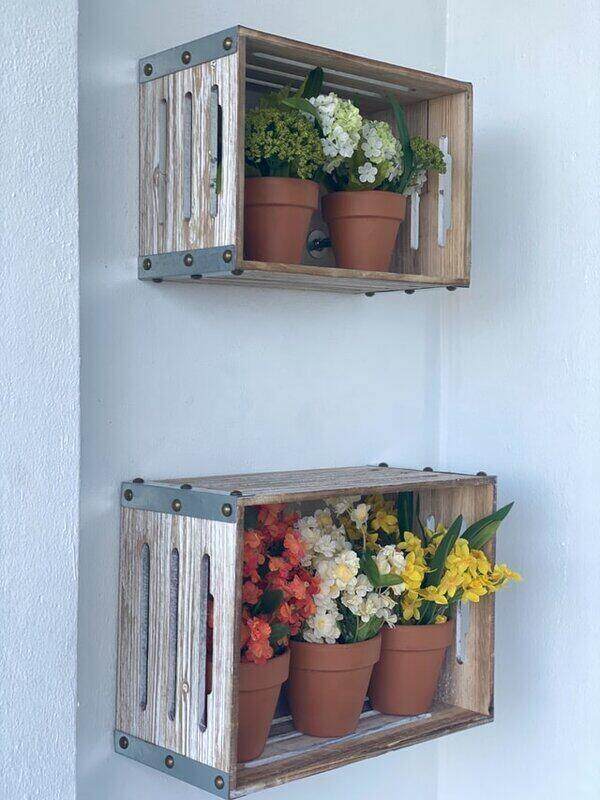
Repurpose old wooden crates to build one of these best vertical gardening ideas. Stack them in the corner of the room, or drill them to the wall as shelves. Adorn them with your favorite trinkets and show off your dazzling flower pots.
Advantages:
- Wooden crates offer your New York home or apartment a countryside vibe.
- They’re the perfect size for short growing potted plants.
- Stacked crates allow for easy rearrangement.
Best plants:
The best plants to have inside your crates are ones that don’t need too much space to grow and can survive in a small planter pot.
- Succulents
- Air plant
- Lithops
- Pansies
- Herbs
Maintenance tip: Just like outdoor plants, your indoor plants can benefit from fertilizer. Develop a fertilizer schedule for your plants to ensure they get the necessary nutrients to thrive and stay beautiful.
Cost: A set of three wooden crates can cost between $30 and $50.
20. Build a living wall
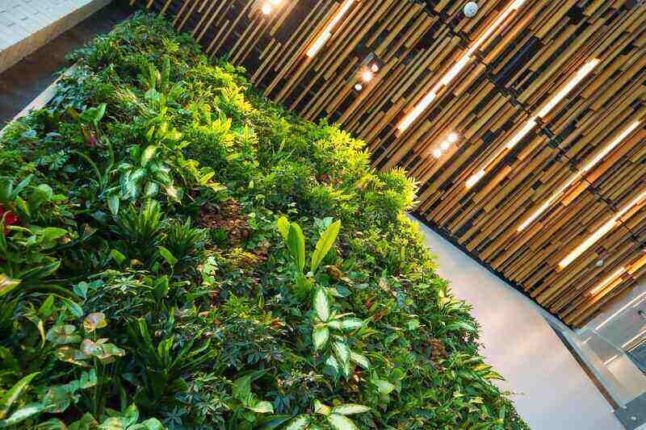
For a grand vertical garden that takes your breath away, turn your entire wall into a green, living wall. The vibrant plants and stimulating textures create a masterpiece that brings you closer to nature–– even when stuck inside.
Whether you work at the home office or love to relax in the living room, a living wall’s greenery can help bring about instant calm and serenity.
Advantages:
- Is a dramatic art piece
- Increases a feeling of well-being
- A green workplace can help increase productivity.
- Purifies the air
- It can help reduce noise.
- Absorbs sunlight, reduces temperatures, and can even help save on energy bills.
Best plants:
This sophisticated vertical garden can grow herbs, perennials, small shrubs, grasses, fruits, and vegetables.
Before installing any plants, talk to your local nursery to determine the best plants that will thrive in your climate and the wall garden’s ecosystem. Replacing dying plants from the wall is an important maintenance step, so you’ll want to make sure the plants you’re growing have the best chance of surviving.
Maintenance tips:
- Remove dead plants and leaves as needed.
- Trim back overgrown plants that are smothering small ones.
- Perform a routine inspection to ensure the irrigation system is in working order.
Cost: The cost of a living wall will vary depending on square feet and the quality of plants you choose. Turn it into a DIY project at home with this instructional video by HGTV Canada.
The Bottom Line
Living in New York City has its challenges, and staying close to nature is one of them. A stroll through Central Park can satisfy your need for greenery, but only for a short while.
Growing a plant or small garden inside your home can make all the difference. And while the limited indoor space and missing front yard make gardening seem out of the question, vertical gardening may be just what your green thumbs need to make the impossible possible.
When to Call a Professional
Even an advanced green thumb may find their vertical garden idea challenging to execute. Having trouble designing your hydroponic gardening system or need assistance choosing the right plants for your vertical garden? Call a NYC landscaping professional near you for assistance.
A professional landscaper can help install your vertical garden, provide one-of-a-kind garden designs, and even offer landscaping solutions that work around limited garden space.
Photo Credit: Mark Neal / Pexels